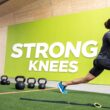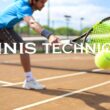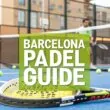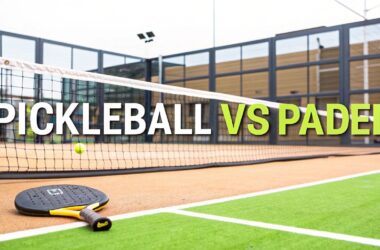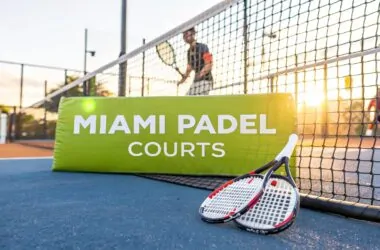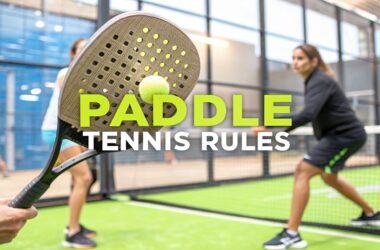The explosive sprints, sharp turns, and powerful smashes in padel take a significant toll on your body. While the thrill of the match is undeniable, what you do after you step off the court is just as crucial for your progress and longevity in the sport. Effective recovery isn't just about avoiding soreness; it's about repairing muscle fibers, replenishing energy stores, and preparing your body to come back stronger for the next game. Neglecting this phase can lead to fatigue, decreased performance, and a higher risk of injury.
This guide moves beyond generic advice to provide seven specialized, actionable muscle recovery tips tailored for the unique demands of padel. We will explore everything from strategic nutrition to targeted self-myofascial release techniques that go hand-in-hand with professional treatments. To delve deeper into this powerful technique, consider exploring a complete guide to massage for muscle recovery that outlines various methods and their benefits. This article focuses on practical strategies you can implement yourself, ensuring you can minimize downtime and maximize your on-court potential. Let's dive into the methods that separate amateur players from those who consistently perform at their best.
1. Progressive Muscle Relaxation and Static Stretching
Combining Progressive Muscle Relaxation (PMR) with static stretching creates a powerful, two-pronged approach to post-padel recovery. This method systematically targets muscle tension by first intentionally contracting a muscle group and then releasing it, a technique developed by Dr. Edmund Jacobson. This conscious tensing and releasing cycle significantly enhances your ability to recognize and alleviate involuntary muscle tightness, making it one of the most effective muscle recovery tips for athletes.
Following this relaxation phase with targeted static stretching maximizes the benefits. The initial PMR sequence increases blood flow and primes the muscles for a deeper, more effective stretch, helping to flush out metabolic byproducts like lactic acid that accumulate during an intense match.

Buy the best padel gear to level up your next game!
CHECK OUT this deal from Padel Market!Get ready to take your game to the next level with the latest padel gear from Padel Market! Fast EU and Worldwide Shipping
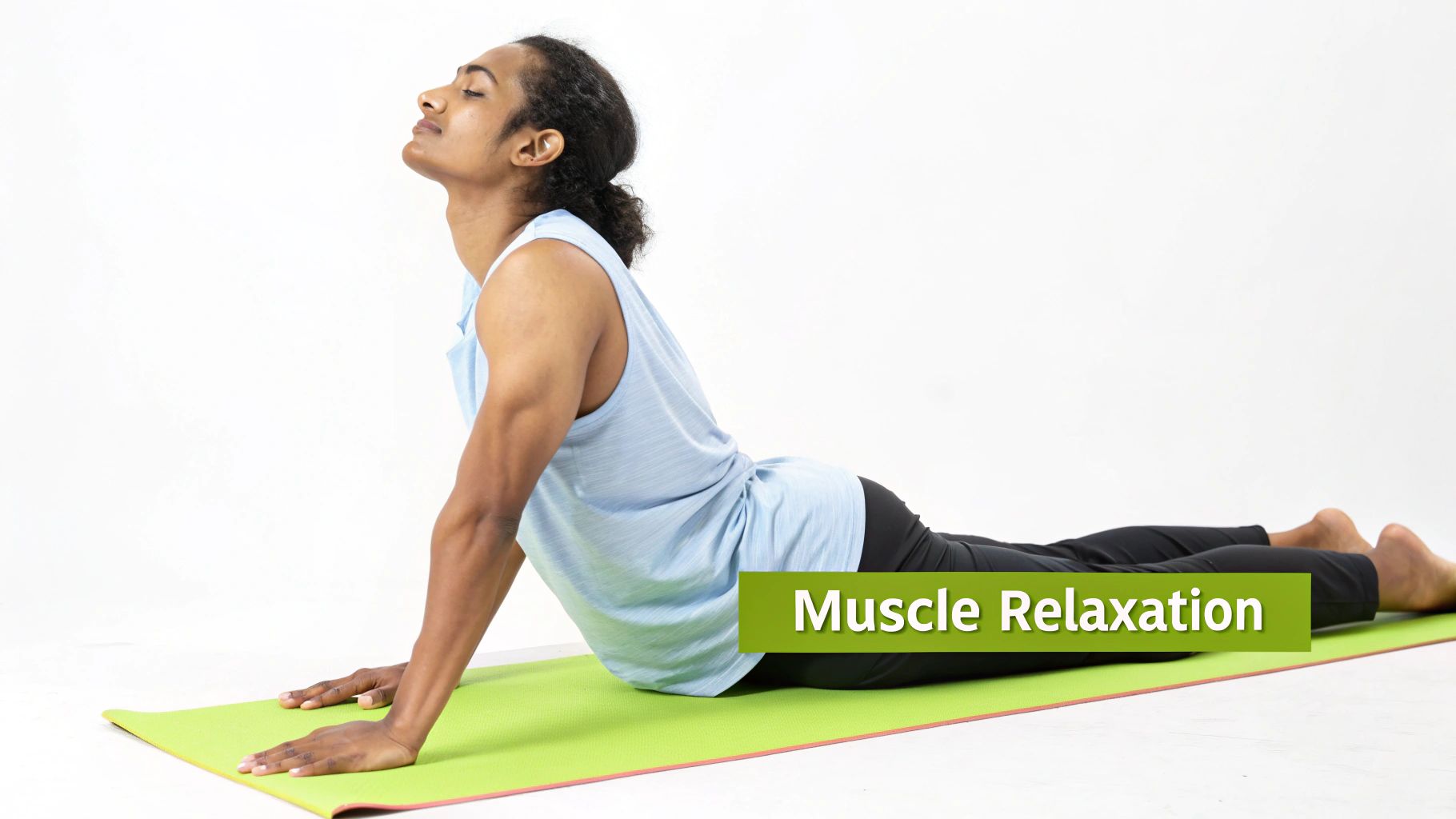
How to Implement PMR and Stretching
The ideal time to perform this routine is within an hour or two after your cool-down, in a quiet and comfortable space where you can fully relax without distractions.
- PMR Sequence: Start with your feet and work your way up. Tense the muscles in your feet for 5-10 seconds, focusing on the feeling of contraction. Then, release the tension completely for 20-30 seconds, noticing the sensation of relaxation. Progressively move up through your calves, quadriceps, glutes, core, chest, arms, and finally your neck and face.
- Static Stretching: After completing the PMR sequence, begin your static stretches. Focus on the major muscle groups used heavily in padel, such as the glutes, hamstrings, quadriceps, calves, chest, and shoulders.
- Holding Time: Hold each stretch for 30-60 seconds without bouncing. This duration allows the muscle fibers and connective tissues to elongate safely and effectively.
- Breathing is Key: Throughout both PMR and stretching, practice deep, diaphragmatic breathing. Inhale as you prepare and exhale slowly as you relax the muscle or deepen the stretch. This enhances relaxation and oxygen delivery to the tissues.
This combined technique is a cornerstone of recovery protocols used by professional sports teams and physical therapy clinics. It not only addresses the physical aspects of muscle soreness but also calms the nervous system, reducing overall stress and preparing your body for its next challenge on the court.
2. Cold Water Immersion Therapy
Cold Water Immersion (CWI), often referred to as an ice bath, is a potent recovery technique involving submerging the body in cold water (typically 50-59°F or 10-15°C) shortly after intense physical activity. The primary mechanism behind its effectiveness is cold-induced vasoconstriction, the narrowing of blood vessels. This process helps to dramatically reduce inflammation, numb nerve endings to alleviate muscle soreness, and flush metabolic waste products like lactate from the tissues, making it one of the most powerful muscle recovery tips for dedicated athletes.
When you exit the cold water, the body warms up, causing rapid vasodilation (widening of the blood vessels). This "pumping" action re-infuses the muscles with fresh, oxygenated blood, which accelerates the repair of microscopic muscle damage sustained during a grueling padel match. This method has been widely adopted by elite athletes, from NBA teams using cryo-chambers to professional rugby players making ice baths a mandatory part of their post-game ritual.
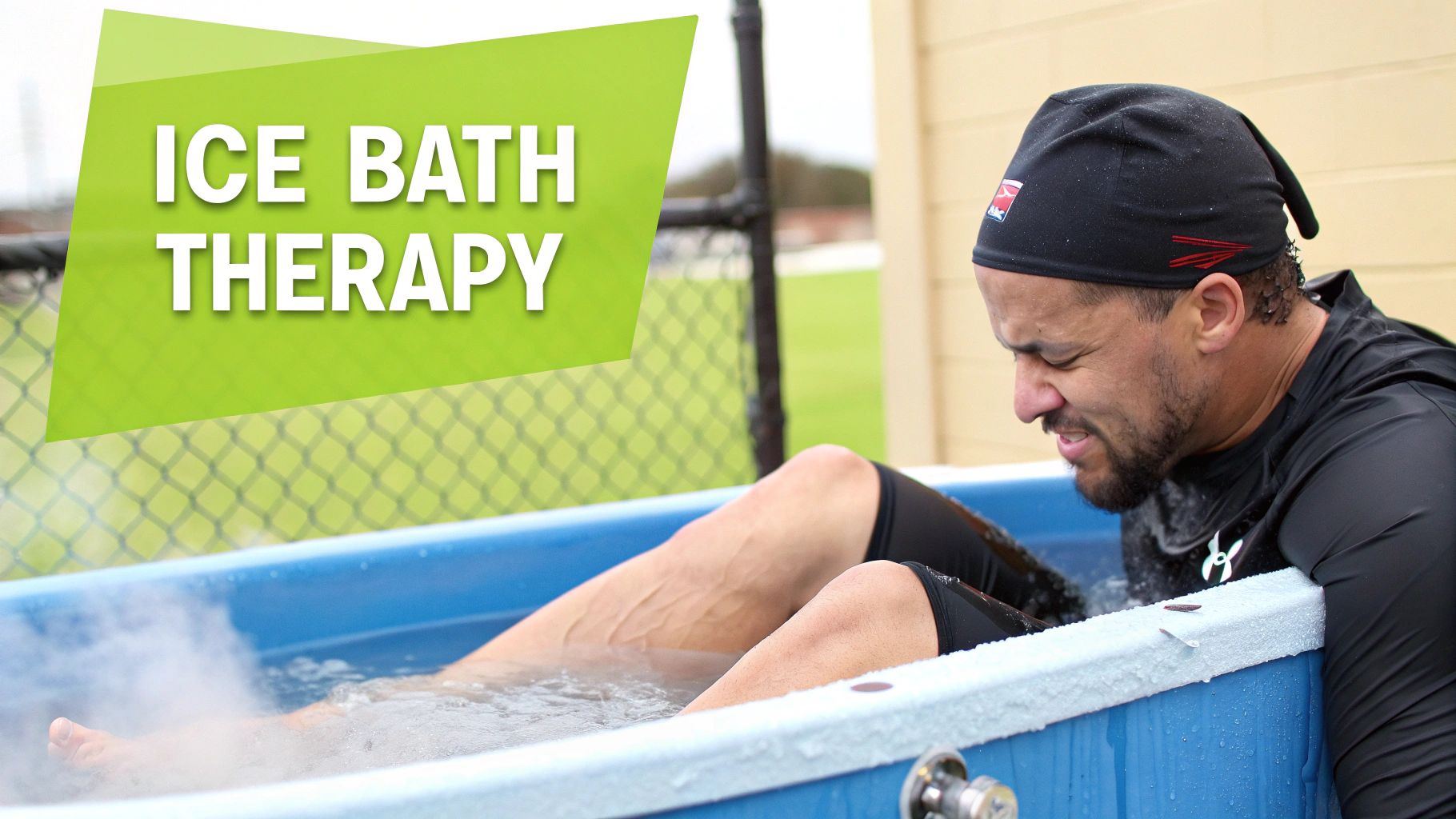
How to Implement Cold Water Immersion
The ideal window for CWI is within 30-60 minutes after your cool-down to maximize its anti-inflammatory effects. The goal is to manage the acute inflammation from the workout without blunting the long-term training adaptations.
- Temperature and Duration: Aim for a water temperature of 50-59°F (10-15°C). Submerge your body up to your waist or chest for 10-15 minutes. Beginners should start with shorter durations of 5-8 minutes and gradually increase their tolerance.
- Controlled Breathing: The initial shock can cause hyperventilation. Focus on slow, deep, controlled breaths, similar to box breathing (inhale for 4 seconds, hold for 4, exhale for 4, hold for 4). This helps calm the nervous system and makes the experience manageable.
- Timing is Critical: Use cold therapy after intense matches or high-volume training sessions to combat muscle damage and soreness. Avoid it immediately before strength training, as the anti-inflammatory effect can slightly inhibit muscle protein synthesis.
- Consider Contrast Therapy: For a less intense but still effective alternative, try contrast therapy. Alternate between 1-2 minutes in cold water and 1-2 minutes in warm (not hot) water, repeating for 3-5 cycles. This creates a powerful vascular pump to aid recovery.
Popularized by figures like Wim "The Iceman" Hof and backed by research from scientists like Dr. Rhonda Patrick, CWI is a scientifically-validated tool. It addresses post-exercise inflammation at its source, significantly reducing Delayed Onset Muscle Soreness (DOMS) and preparing your body to perform at its peak in your next session.
3. Strategic Sleep Optimization
Strategic Sleep Optimization is arguably the most critical yet often overlooked of all muscle recovery tips. It goes beyond simply getting more hours in bed; it's a deliberate approach to maximizing the quality and timing of your sleep to harness its powerful restorative effects. During deep sleep, the body ramps up the release of human growth hormone (HGH) and protein synthesis, two essential processes for repairing muscle micro-tears, rebuilding tissue, and solidifying motor skills learned on the court.
This is the time when the physical adaptations from your padel match truly take hold. Elite athletes like LeBron James, who famously sleeps up to 12 hours a day during training, and elite military units use sleep optimization as a non-negotiable performance enhancer. By treating sleep as a strategic activity, you can significantly accelerate recovery and reduce the risk of overtraining.
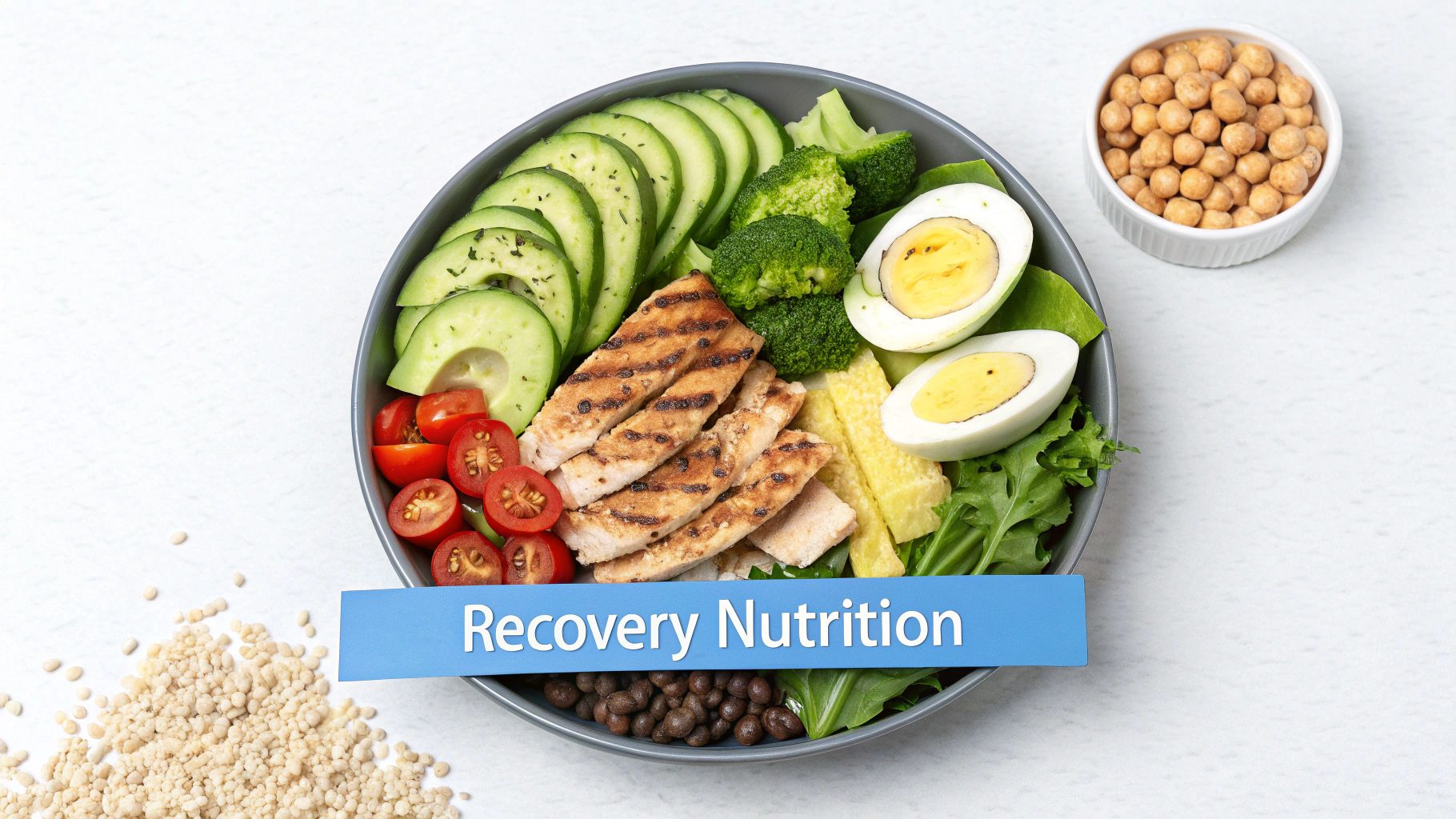
How to Implement Strategic Sleep Optimization
The goal is to create an environment and routine that signals to your body it's time for deep, uninterrupted rest, especially on nights following intense padel sessions. To truly unlock peak recovery, implementing effective sleep strategies is paramount. Dive deeper into strategies for achieving a truly restful night's sleep to master your nighttime routine.
- Create a Sleep Sanctuary: Your bedroom should be reserved for sleep. Keep it cool, ideally between 65-68°F (18-20°C), completely dark, and quiet. Use blackout curtains, an eye mask, or earplugs if necessary to eliminate disruptions.
- Establish Consistency: Go to bed and wake up at the same time every day, even on weekends. This helps regulate your body's internal clock, or circadian rhythm, making it easier to fall asleep and wake up naturally.
- Implement a Digital Sunset: The blue light from screens (phones, tablets, TVs) can suppress melatonin production, the hormone that controls your sleep-wake cycle. Power down all electronics 1-2 hours before bedtime.
- Consider Smart Supplementation: If you struggle to wind down, supplements like magnesium glycinate can help calm the nervous system. Consult a healthcare professional before adding any new supplements to your regimen.
By prioritizing sleep with the same dedication you give to your training, you provide your body with the fundamental tools it needs for cellular repair and hormonal regulation. This disciplined approach ensures you return to the padel court stronger, faster, and more resilient.
4. Targeted Nutrition Timing and Composition
Targeted Nutrition Timing, also known as nutrient timing, is a scientifically-backed strategy that focuses on consuming specific nutrients at optimal times to accelerate muscle repair. This approach leverages the body's post-exercise state, particularly the "anabolic window," when muscles are most receptive to nutrient absorption. By providing the right building blocks at the right time, you can significantly enhance muscle protein synthesis, replenish depleted energy stores, and reduce inflammation, making it one of the most crucial muscle recovery tips for any dedicated padel player.
This isn't just about eating healthy; it's about strategic consumption to maximize recovery outcomes. Leading sports nutritionists like Dr. John Ivy and Dr. Louise Burke have pioneered research showing that what you eat and when you eat it can dramatically influence how your body adapts to training stress. Properly timed nutrition helps to reverse the catabolic (breakdown) state induced by an intense match and kickstart the anabolic (rebuilding) process.
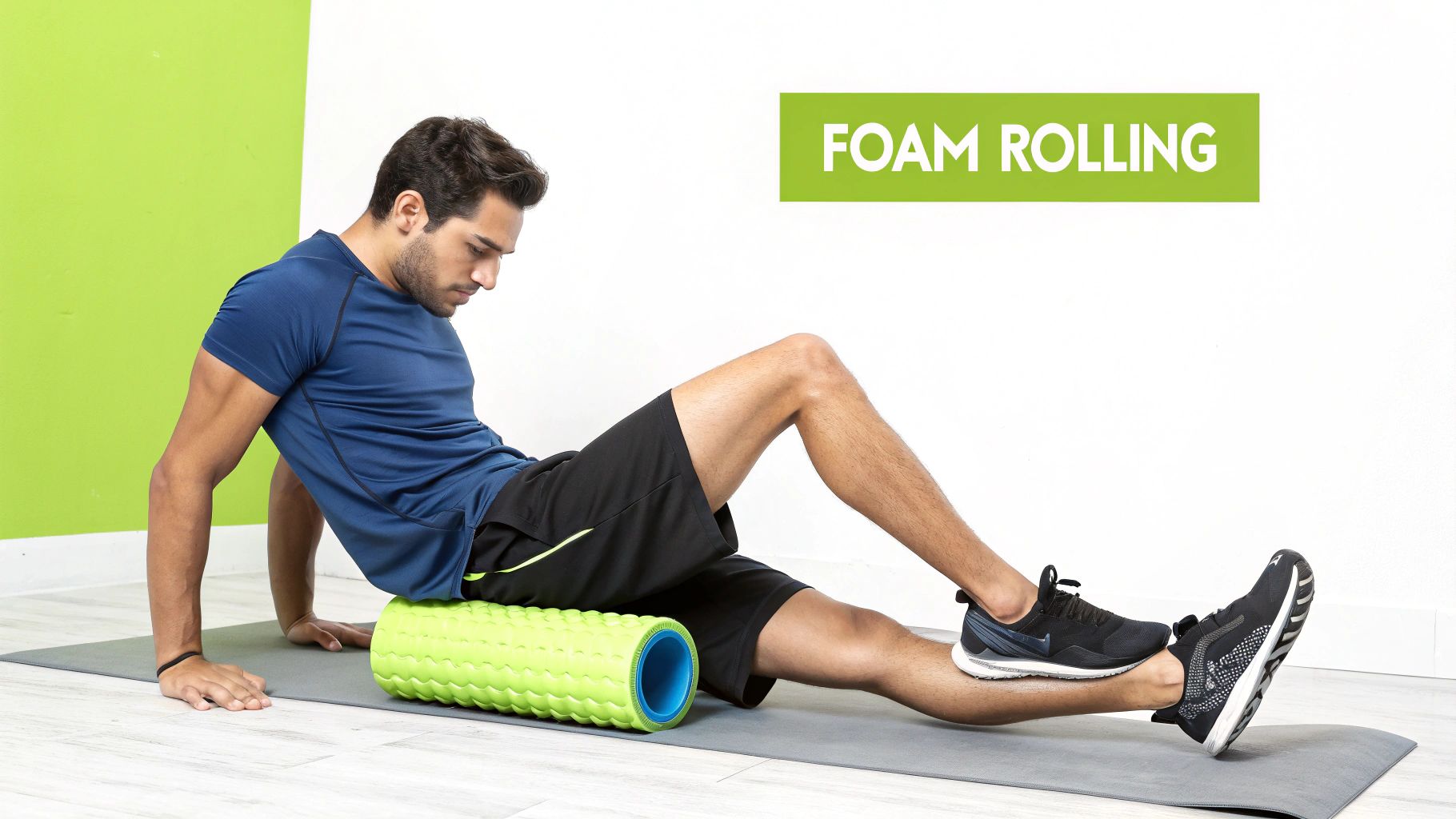

Buy the best padel gear to level up your next game!
CHECK OUT this deal from Padel Market!Get ready to take your game to the next level with the latest padel gear from Padel Market! Fast EU and Worldwide Shipping
How to Implement Targeted Nutrition
The most critical window for nutrient timing is within the first two hours after your padel match, with the first 30-60 minutes being the "golden hour" for optimal absorption and glycogen resynthesis.
- Prioritize Protein: Consume 20-40 grams of high-quality, fast-digesting protein like whey, casein, or a plant-based blend within this two-hour window. This provides the essential amino acids needed to repair microscopic muscle tears. A simple protein shake or a meal with lean chicken or fish is an excellent choice.
- Replenish with Carbohydrates: Your muscles' primary fuel source, glycogen, is heavily depleted during a match. Aim for a 3:1 or 4:1 carbohydrate-to-protein ratio to rapidly restore these stores. For a 30g protein shake, this would mean adding 90-120g of carbohydrates from sources like bananas, oats, or a sports drink.
- Incorporate Anti-Inflammatories: Natural anti-inflammatory foods can help manage post-exercise soreness. Consider adding tart cherry juice, turmeric (with black pepper for absorption), or omega-3-rich foods like salmon or chia seeds to your recovery meals.
- Rehydrate Effectively: Dehydration can severely hinder recovery. A practical rule is to drink 1.5 liters of fluid for every 1 kg of body weight lost during exercise. Weigh yourself before and after your match to get an accurate measurement, and include electrolytes to restore mineral balance.
This strategic approach is a staple in the routines of elite athletes across all sports, from endurance runners to professional padel players. By treating your post-match nutrition with the same precision as your on-court technique, you ensure your body has everything it needs to repair, rebuild, and come back stronger for the next game.
5. Foam Rolling and Self-Myofascial Release
Foam rolling, a form of self-myofascial release (SMR), is a self-administered soft tissue therapy that has become a staple in athletic recovery. This technique uses tools like foam rollers, massage balls, or percussion devices to apply controlled pressure to muscles and the surrounding fascia. This pressure helps to break up adhesions, or "knots," in the muscle tissue, improving flexibility and reducing soreness, making it one of the most accessible muscle recovery tips.
By targeting these tight spots, SMR increases blood flow to the affected area, delivering vital oxygen and nutrients that accelerate the healing process. This method, popularized by mobility experts like Kelly Starrett and integrated into routines by countless professional sports teams, directly addresses the tissue quality issues that can arise from the explosive, multi-directional movements common in padel.
How to Implement Foam Rolling and SMR
For maximum benefit, integrate SMR into your cool-down routine or perform it on a rest day. It is particularly effective for addressing soreness in large muscle groups heavily used during a padel match.
- Pacing and Pressure: Move slowly across the muscle, at a rate of about one inch per second. When you find a tender spot or trigger point, pause and hold the pressure for 20-30 seconds until you feel the tension begin to release.
- Target Major Muscle Groups: Focus on key padel muscles like the glutes, quadriceps, hamstrings, calves, and the thoracic spine (upper/mid-back). Avoid rolling directly over joints, bones, or your lower back, which can cause injury.
- Duration: Spend approximately 1-2 minutes per muscle group. Over-rolling can lead to bruising or tissue damage, so consistency is more important than marathon sessions.
- Synergize with Breathing: Coordinate your movements with deep, controlled breathing. Exhale as you apply pressure to a tender area to help your nervous system relax and allow the muscle to release more effectively.
This proactive approach to tissue maintenance not only helps you recover faster from DOMS but also improves your mobility and range of motion. By keeping your muscles pliable and free of restrictions, you enhance your on-court performance and significantly reduce your risk of strains and other soft-tissue injuries.
6. Active Recovery and Low-Intensity Movement
Active recovery is a counterintuitive yet highly effective strategy that involves performing light physical activity on rest days instead of remaining completely sedentary. This approach, championed by endurance coaches and professional sports teams, promotes blood circulation to sore muscles without imposing additional strain. This increased blood flow delivers vital oxygen and nutrients while helping to clear out metabolic waste products, accelerating the repair process and reducing stiffness.
Engaging in low-intensity movement keeps your muscles and joints mobile, preventing them from tightening up after a demanding padel match. This makes it one of the most practical muscle recovery tips for athletes who need to maintain performance levels consistently. It gently reminds your body of its movement patterns, which can help you feel less sluggish and more prepared for your next high-intensity session on the court.
How to Implement Active Recovery
The key is to keep the intensity extremely low and the duration moderate. The goal is to feel better after the session, not more tired. This should be performed on a dedicated rest day or at least 24 hours after a strenuous match.
- Choose Low-Impact Activities: Opt for exercises that are gentle on your joints. Excellent options for padel players include a light cycle, a brisk walk, swimming, or flowing yoga. These activities move your body through a range of motion without the high-impact stress of running or jumping.
- Keep Intensity Conversational: A simple rule is the "talk test." You should be able to hold a full conversation comfortably throughout the activity. If you find yourself breathing too heavily to speak in complete sentences, you are working too hard.
- Duration and Timing: Aim for a session lasting 20-40 minutes. This is long enough to stimulate blood flow and warm up the muscles without causing further fatigue or depleting energy stores needed for muscle repair.
- Listen to Your Body: Active recovery is not about pushing through pain. If a particular movement causes discomfort, stop or modify it. The purpose is to facilitate healing, not to add more stress to an already taxed system.
This method bridges the gap between intense exertion and complete rest, creating an optimal environment for your body to rebuild. By incorporating light, purposeful movement into your off-days, you can significantly shorten your downtime and return to the padel court feeling refreshed and ready to perform.
7. Stress Management and Mental Recovery
A holistic approach to athletic performance recognizes that physical strain doesn't exist in a vacuum. Stress Management and Mental Recovery are critical components of a comprehensive plan, as psychological and emotional stress directly inhibit the body's ability to heal. High levels of cortisol, the body's primary stress hormone, can interfere with muscle repair, disrupt sleep, and prolong inflammation, making this one of the most overlooked yet essential muscle recovery tips.
Adopting mindfulness and stress-reduction techniques helps downregulate the nervous system from a "fight or flight" state to a "rest and digest" state, which is optimal for healing. This mental reset allows physiological recovery processes, such as protein synthesis and tissue repair, to function more efficiently. This concept has been championed by figures like sports psychologist Dr. Michael Gervais and implemented by elite organizations like the Seattle Seahawks, who integrate mindfulness to enhance both performance and recovery.
How to Implement Mental Recovery Practices
Incorporate these techniques into your daily routine, especially after demanding training sessions or matches, to accelerate your return to peak condition. Consistency is more important than duration, particularly when starting out.
- Guided Meditation: Begin with just 5-10 minutes of guided meditation each day. This practice trains your focus and calms the nervous system. Apps like Headspace or Calm offer structured programs specifically designed for athletes focusing on recovery, sleep, and performance.
- Mindfulness-Based Stress Reduction (MBSR): Popularized by Jon Kabat-Zinn, MBSR involves non-judgmental awareness of the present moment. Try a simple body scan meditation, where you bring attention to each part of your body, noticing sensations without trying to change them.
- Strategic Disconnection: Create clear boundaries between your padel training and personal life. Consciously "switch off" from the sport to allow your mind to rest. This mental break is as crucial as physical rest days.
- Deep Breathing Exercises: Practice diaphragmatic breathing. Inhale slowly through your nose for a count of four, hold for four, and exhale slowly through your mouth for a count of six. Repeating this for a few minutes can immediately lower cortisol levels and calm your mind.
Integrating these mental recovery strategies complements physical efforts like nutrition and stretching. By managing stress, you create the ideal internal environment for your body to repair, adapt, and grow stronger, ensuring you're not just physically but also mentally prepared for your next game.
Muscle Recovery Methods Comparison
| Recovery Method | Implementation Complexity 🔄 | Resource Requirements ⚡ | Expected Outcomes 📊 | Ideal Use Cases 💡 | Key Advantages ⭐ |
|---|---|---|---|---|---|
| Progressive Muscle Relaxation and Static Stretching | Moderate (15-30 min sessions) | Minimal (no equipment needed) | Gradual reduction in muscle soreness and improved flexibility | Post-training recovery, physical therapy, yoga studios | Reduces soreness, promotes mental relaxation, cost-effective |
| Cold Water Immersion Therapy | Moderate (10-20 min immersion) | High (cold water source/facility) | Immediate pain relief, reduced inflammation | Post-exercise acute recovery, team sports, cryotherapy centers | Rapid soreness reduction, inflammation control |
| Strategic Sleep Optimization | High (lifestyle adjustments) | Minimal (sleep environment setup) | Enhanced muscle repair & cognitive recovery | All athletes, especially those with intense training schedules | Maximizes growth hormone release, cognitive benefits |
| Targeted Nutrition Timing and Composition | Moderate (meal planning required) | Moderate to High (nutrient quality) | Accelerated muscle protein synthesis and glycogen replenishment | Bodybuilders, endurance athletes, team sports | Optimizes recovery via nutrition, reduces inflammation |
| Foam Rolling and Self-Myofascial Release | Moderate (proper technique needed) | Low to Moderate (foam roller/tools) | Reduced muscle tension, improved mobility | Pre/post-exercise muscle care, physical therapy | Portable, cost-effective, improves tissue quality |
| Active Recovery and Low-Intensity Movement | Low (simple activities) | Minimal (no special equipment) | Enhanced circulation and reduced stiffness | Rest days, light recovery periods, endurance training | Maintains fitness, promotes blood flow |
| Stress Management and Mental Recovery | Moderate to High (habit formation) | Minimal (guided apps or quiet space) | Reduced cortisol, improved sleep and motivation | Athletes under high stress, mental recovery focus | Supports mental & physical recovery, improves training consistency |
Integrating Recovery into Your Padel Routine
Mastering the art of recovery is not just a supplement to your padel training; it is the very foundation upon which consistent performance and long-term athletic health are built. Throughout this guide, we've explored a powerful arsenal of muscle recovery tips designed to elevate your game. You've learned how to leverage everything from the physiological reset of cold water immersion and strategic sleep optimization to the structural benefits of foam rolling and the nutritional precision of post-match fueling.
The journey from a grueling match back to peak readiness is a proactive process. It requires shifting your mindset from viewing recovery as a passive waiting period to seeing it as an active, strategic component of your overall athletic plan. The insights shared here are not isolated tricks but interconnected elements of a holistic system. The quality of your sleep directly impacts your nutritional cravings and hormonal balance, while effective stress management can improve your ability to relax into deep, restorative stretches.
From Knowledge to Action: Building Your Recovery Blueprint
The key to unlocking the benefits of these techniques lies in consistent, personalized application. Simply knowing these strategies exist is not enough. The most successful players are those who experiment, listen to their bodies, and build a routine that works for them.
Here’s a practical path forward:
- Start Small, Win Big: Don't try to implement all seven strategies at once. Choose one or two that seem most accessible or address your biggest pain points. If post-match soreness is your primary issue, commit to 10 minutes of foam rolling and a dedicated protein-and-carb snack within an hour of every game for the next two weeks.
- Track and Adapt: Monitor your results. Keep a simple journal noting your energy levels, perceived soreness (on a scale of 1-10), and on-court responsiveness. This data will provide invaluable feedback, telling you what's working and what needs adjustment.
- Create a System, Not a Checklist: The ultimate goal is to integrate these practices so seamlessly that they become second nature. For example, your "post-match system" could automatically be: cool-down static stretch, immediate recovery shake, and a 15-minute foam rolling session at home. This removes the guesswork and ensures you never skip the essentials.
By embracing these muscle recovery tips, you are doing more than just alleviating soreness. You are investing in injury prevention, enhancing your capacity for more intense training, and ensuring you can step onto the court for every match feeling powerful, sharp, and ready to compete. Remember, the champions on the padel court are not just the ones who train the hardest; they are the ones who recover the smartest.
Ready to take your game to the next level with the right gear and insights? Visit Padel Rumors for expert reviews, performance guides, and the latest news in the padel world. Find the perfect equipment to support both your performance and recovery at Padel Rumors.



